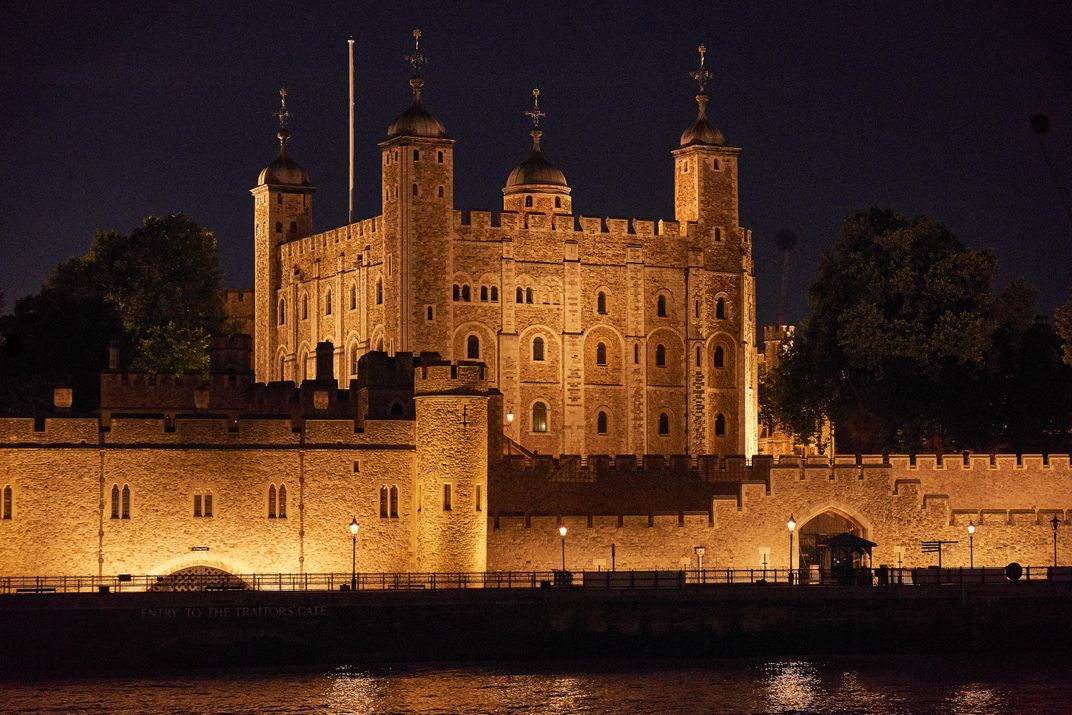Archaeologists Discover Medieval Woman and Child’s Skeletons at the Tower of London
The remains shine a light on the ordinary people who lived and worked in one of England’s most notorious historic sites
:focal(4415x1755:4416x1756)/https://tf-cmsv2-smithsonianmag-media.s3.amazonaws.com/filer/ae/57/ae5717ae-9750-402a-9154-ada69ecb008a/historic_royal_palaces_curator_alfred_hawkins_inspects_late_medieval_remains_uncovered_at_tower_of_london_1_copyright_and_credit_historic_royal_palaces-1.jpg)
Since the 16th century, the Chapel of St. Peter ad Vincula has served as a spiritual haven within the Tower of London—and as the burial place for some of the fortress’ most famous prisoners, among them Henry VIII’s ill-fated second and fifth wives, Anne Boleyn and Catherine Howard, respectively.
The site’s modern caretakers recently launched a project aimed at making the chapel more accessible, but before building work began, they had to excavate the area to ensure any hidden historic relics found were appropriately protected. This spring, curator Alfred Hawkins announced in a Historic Royal Palaces’ blog post, archaeologists unearthed the complete skeletons of a medieval woman and child—likely commoners who lived and worked within the Tower walls. The discovery highlights the dynamic nature of a site most frequently associated with the gruesome deaths of England’s rich and powerful.
Per the Telegraph’s Dalya Alberge, the remains date to between 1450 and 1550: a period spanning the Wars of the Roses, the reign of Henry VIII, and the ascension of his much longed-for son, Edward VI. Both individuals were interred on their backs with their feet facing east, as was typical for Christian burials at the time. Nails found around the woman’s skeleton suggest she was buried in a coffin, but the child appears to have been simply wrapped in a shroud before being placed in the ground.
The researchers did not find any burial goods with the skeletons, but an osteoarchaeologist, a bone specialist chiefly concerned with studying archaeological finds, who assessed the remains suggested the woman died between the ages of 35 and 45. The child, on the other hand, was only around 7 years old.
Neither skeleton shows any signs of a violent death, suggesting the two were not executed prisoners, but rather individuals linked with one of the Tower’s less punitive functions: Among others, Alberge notes, the pair could have had ties to the Royal Mint, the Royal Armories or the soldiers tasked with guarding the monarchy’s Crown Jewels. Both skeletons displayed markers of illness, and the woman likely suffered from chronic back pain.
“Their growth shows not a comfortable life, but one which is typical of the period in which they lived,” Hawkins writes.

As Brandon Specktor explains for Live Science, the recent find is particularly exciting because the skeletons represent the first human remains unearthed at the Tower since the 1970s, as well as the first to be analyzed by an osteoarchaeologist. At the same time, Hawkins reports, the excavation has “turned our understanding of the Chapel upside down.”
The first major discovery to surface during the spring survey was the fragmentary skeleton of a dog, which was found beneath a mortar surface linked with a building constructed prior to 1681. (The remains were affectionately nicknamed Jeff, according to the blog post.) As archaeologists dug deeper, they were surprised to spot a second mortar surface: Nearly nine inches thick, the block was likely “used as a base for a very substantial and high-status floor.” The mortar’s depth, combined with documentary evidence and pieces of medieval glazed tile found at the site, led archaeologists to suspect they had discovered the floor of a chapel built by Edward I but destroyed in an early 16th-century fire. Previously, researchers had believed the 13th-century structure was located in a completely different area.
“We prepared for the fact that there may be complete burials, but we weren’t expecting them to be there because historic records show that the burial site was in a different location,” Hawkins tells the Telegraph.
The Tower of London is perhaps best known for its connections to the many macabre dramas of England’s history. It was there that the likes of Anne Boleyn and Thomas More were executed and figures including Elizabeth I, Sir Walter Raleigh, Guy Fawkes and the Princes in the Tower imprisoned. (Although popular lore suggests the much-maligned Richard III ordered the young princes’ murder following his usurpation of the throne, two sets of bones found under a staircase in 1674 have never been definitively proven to represent the brothers’ remains.) Still, over the course of its nearly 1000-year history, the Tower has functioned as much more than a prison. Construction began in the 1070s under the orders of William the Conqueror, who sought to solidify his rule with a fortress that would loom high over vanquished Londoners, and as the site expanded into a complex with additional fortifications and towers, builders added lavish royal lodgings, a menagerie, a mint, and a tower for storing royal garments and the Crown Jewels.
Recent discoveries show the Tower “has also been a home to those who worked within its walls,” Hawkins writes.
“Often, an archaeological excavation, and the information you can gain from it, feels fairly impersonal—uncovering a Norman ditch here, a Tudor tile there,” he adds. “All of these physical remains enable us to create an image of the past, but the individual history of the people who lived in these periods can sometimes be elusive. ... This is why the archaeological excavation of human remains is so important: it allows us to examine the way in which people lived and died in our palaces.”